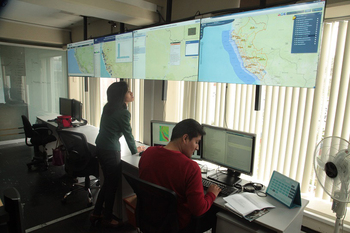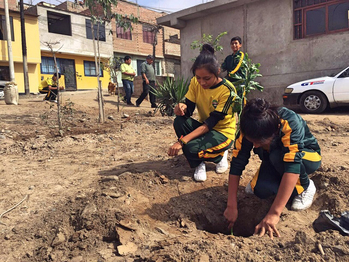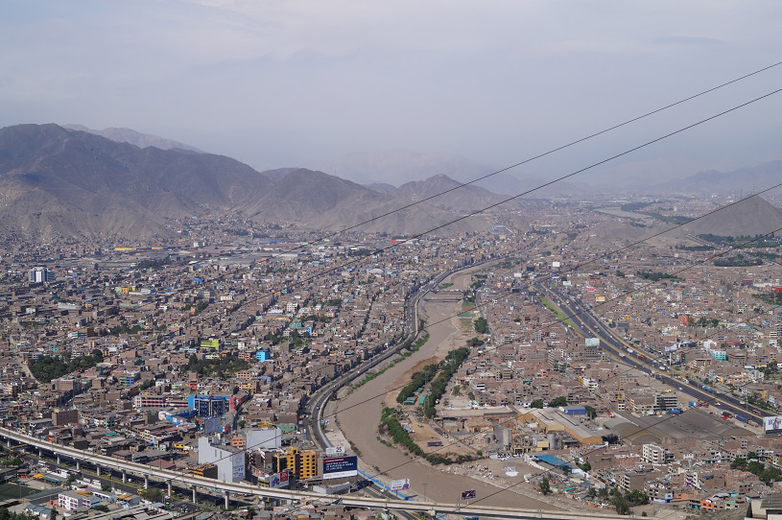Adapting urban water resources management to climate change with private sector participation
Project description
Title: Adapting urban water resources management to climate change with private sector participation (ProACC)
Commissioned by: German Federal Ministry for Economic Cooperation and Development (BMZ)
Country: Peru
Lead executing agency: National Water Authority (Autoridad Nacional del Agua - ANA)
Overall term: 2014 to 2019

Context
The water supply of Lima, which has a population of 10 million, depends mainly on the Chillón, Rímac and Lurín rivers. Climate-related fluctuations in the available volume of water and the increasing water demand are already leading to serious seasonal water shortages. Pollution from mining, unregulated waste disposal and industrial and domestic wastewater discharges further affect available water resources. The resulting challenges –scarce water resources, uncontrolled withdrawals and growing pollution as urbanisation increases – are aggravated by the consequences of climate change. Without interaction between all relevant stakeholders, especially the private sector, these challenges cannot be overcome.
Objective
With the involvement of the private sector, water resources management in the Chillón, Rímac and Lurín river basins is oriented towards climate change adaption.

Approach
The project advises the Peruvian National Water Authority (Autoridad Nacional del Agua – ANA) on improving water management in the Chillón, Rímac and Lurín river basins. In order to ensure the quality and continuity of Lima's water supply in the long term, cooperation between public and private stakeholders is strengthened. The German contribution provides technical support, facilitates knowledge transfer and promotes the concept of public-private stewardship. It cooperates closely with the consortium of the consulting firms AMBERO and GITEC.
- Establishment of a water observatory. In collaboration with private and public sector stakeholders, the establishment and operation of a water resources observatory is promoted. This observatory uses modern technology to provide information for decision-makers, such as the newly established watershed commission of the Chillón, Rímac and Lurín rivers. This is a crucial prerequisite for achieving integrated water management in times of climate change.
- Cross-sectoral public-private projects. Development partnerships with the private sector encourage the involvement of private companies in the protection of water resources. New initiatives are promoted that contribute to climate change adaptation, benefiting both companies and the general public.
- Reuse of treated wastewater. In cooperation with Lima’s water and sanitation utility SEDAPAL, strategies and measures are being developed for reusing treated wastewater in the cities of Lima and Callao.
- Strategies for adaptation to climate change. Private sector partners, the city’s water utility SEDAPAL and public administration at local and regional level are supported in developing plans for adapting to climate change. Together, current challenges are identified and corresponding adaptation measures integrated into activities.
Results
- The water resources observatory for Lima’s river basins was founded in July 2016. The information provided and prepared by the observatory allows the watershed commission of the Chillón, Rímac and Lurín rivers to take decisions based on reliable data, ensuring knowledge-based water management.
- Six public-private initiatives for climate change adaptation have been developed and implemented in urban districts and rural communities suffering from extreme water shortages. Innovative methods that generate leverage for joint action in times of climate change are thereby demonstrated. These also save money and water – water that can be used more meaningfully elsewhere, for example for the supply of drinking water or the irrigation of green areas.
- Twelve parks in various districts of Lima are watered using treated wastewater. Several hectares of green space are to be added. This saves valuable drinking water and improves the quality of life of city residents.
- Eighteen local municipalities and the city’s water utility SEDAPAL have been made more aware of climate change adaptation and have developed corresponding adaptation plans. In this way, the institutions’ resilience and capacity to adapt to future extreme weather events (droughts, heavy rainfall and flooding) are strengthened with the involvement of the private sector.
